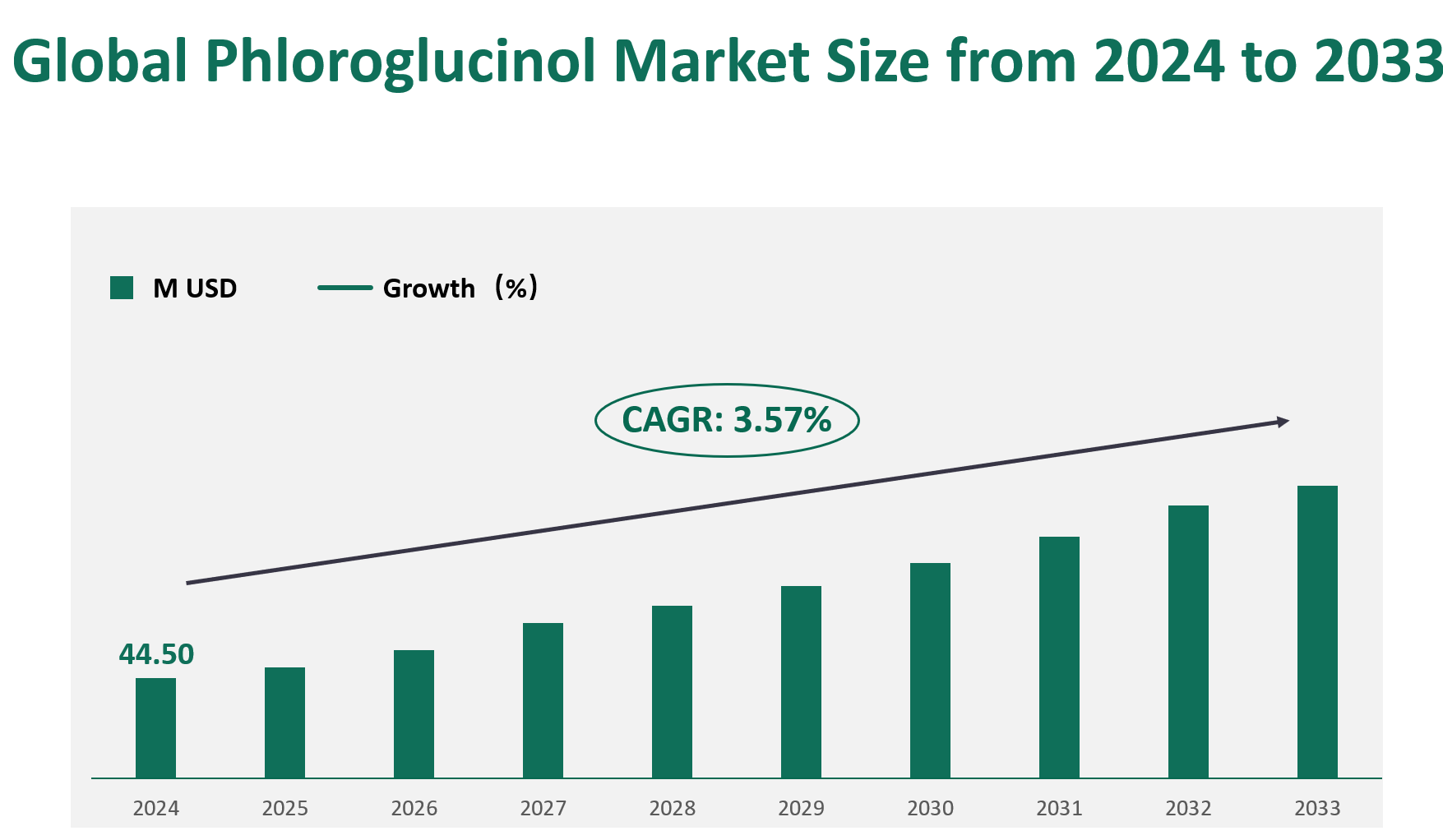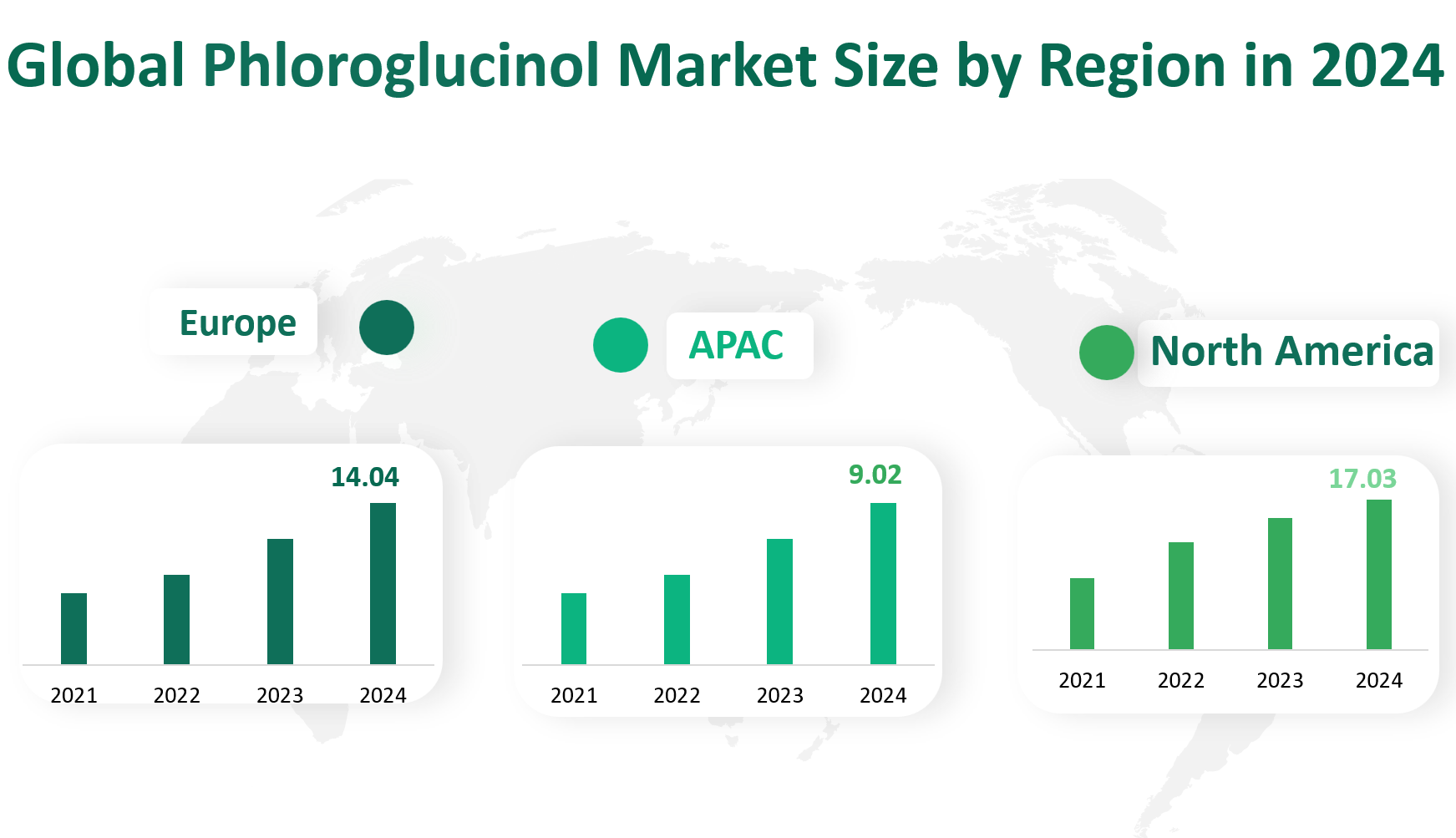1. Global Phloroglucinol Market Insight Analysis
In 2024, the global Phloroglucinol market is projected to reach a revenue of 44.50 million USD. This figure reflects a steady growth trend, with a Compound Annual Growth Rate (CAGR) of 3.57% from 2024 to 2033.
Phloroglucinol is an organic compound with the molecular formula C₆H₆O₃, and a molecular weight of 126.11 g/mol. It is primarily used in the pharmaceutical industry as a spasmolytic agent to treat conditions such as gastrointestinal spasms, biliary tract pain, and other digestive disorders. Phloroglucinol is also used in the treatment of gallstones, bladder spasms, and irritable bowel syndrome. Beyond its medical applications, Phloroglucinol serves as a coupling agent in the textile dyeing process, particularly in the formation of fast black dyes. Additionally, it is utilized in the production of adhesives and as a component in hair dyes and other cosmetic products. Its versatility across multiple industries underscores its importance in modern manufacturing and healthcare.
Figure Global Phloroglucinol Market Size (M USD) and CAGR (2024-2033)

2. Driving and Limiting Factors of Phloroglucinol Market Growth
The growth of the market is influenced by several key factors. One of the primary drivers is the increasing demand from the pharmaceutical sector. As the global population ages and lifestyles become more sedentary, the incidence of gastrointestinal disorders and related conditions is rising. This has led to a higher demand as a key ingredient in medications for treating these conditions.
Additionally, the growth of the medical sector, along with advancements in medical procedures, has further boosted the market. For example, Phloroglucinol is used in the treatment of patients undergoing transurethral resection of the prostate (TURP), a common procedure in elderly men.
Another significant driver is the expanding industrial applications of Phloroglucinol. Its use as a coupling agent in printing and as an adhesive in various industrial processes has increased its demand. The growth of the textile industry, in particular, has contributed to the market expansion, as Phloroglucinol is essential in the dyeing process. Furthermore, the cosmetic industry’s increasing focus on hair care products has also driven demand, as Phloroglucinol is a key component in hair dyes.
However, the market also faces several limiting factors. One of the most significant is the strict production regulations associated with Phloroglucinol. The production process is highly technical and requires precise control of temperature and time. Non-compliance with these standards can lead to production failures, increasing costs for manufacturers.
Additionally, environmental concerns have led to stricter regulations on chemical production, including Phloroglucinol. The industry is required to invest in advanced wastewater treatment systems to mitigate environmental impact, which further increases production costs and reduces profit margins.
Another limiting factor is the high entry barrier for new companies. The pharmaceutical industry, which is the largest consumer of Phloroglucinol, is highly regulated. New entrants must comply with numerous regulations and obtain certifications such as GMP (Good Manufacturing Practice). This regulatory complexity, combined with the need for significant investment in production facilities and R&D, makes it challenging for new players to enter the market.
3. Technology Innovation and Corporate Mergers and Acquisitions in Phloroglucinol Market
Technological innovation is playing a crucial role in the Phloroglucinol market. Companies are increasingly adopting smart manufacturing technologies to improve production efficiency and reduce costs. The Internet of Things (IoT) is being utilized to monitor production processes in real-time, ensuring quality control and optimizing resource usage. This technology also allows for predictive maintenance, reducing downtime and increasing the lifespan of production equipment.
In addition to technological advancements, the market has also witnessed several mergers and acquisitions. For example, Beijing Wisdom Chemicals, a leading player in the market, has expanded its production capacity through strategic acquisitions. The company has integrated multiple production bases to enhance its ability to meet the growing demand for Phloroglucinol. These mergers and acquisitions not only increase market concentration but also allow companies to leverage synergies to improve efficiency and reduce costs.
4. Global Phloroglucinol Market Size by Type
The market is segmented into two primary product types: Pharmaceutical Grade and Industrial Grade. Each type has distinct characteristics and market dynamics.
Pharmaceutical Grade is a high-purity product used primarily in the medical field. It is approved by regulatory bodies such as the United States Pharmacopeia (USP) and the European Pharmacopoeia (EP). This grade of Phloroglucinol is used as a spasmolytic agent to treat gastrointestinal spasms, biliary tract pain, and other digestive disorders. It is also used in the treatment of gallstones and bladder spasms. The pharmaceutical grade is characterized by its high purity and strict quality control standards, making it suitable for use in medications and medical procedures.
Industrial Grade is designed for applications outside the medical field. It is used in the production of adhesives, as a coupling agent in textile dyeing, and in various industrial processes. Industrial-grade Phloroglucinol can tolerate more extreme conditions than pharmaceutical-grade products, making it suitable for industrial use.
In terms of market revenue, the Pharmaceutical Grade segment is projected to have a revenue of $39.30 million USD in 2024, while the Industrial Grade segment is expected to reach $5.20 million USD.
Table Global Phloroglucinol Market Size by Type in 2024
5. Global Phloroglucinol Market Size by Application
Phloroglucinol is utilized across a diverse range of applications, each contributing to the overall market dynamics. The primary applications include Pharmaceuticals, Adhesive Resins, Dyeing Couplers, and Others.
Pharmaceuticals is the largest application segment, with Phloroglucinol used as a spasmolytic agent to treat gastrointestinal spasms, biliary tract pain, and other digestive disorders. It is also used in the treatment of gallstones and bladder spasms. The pharmaceutical application segment is projected to have a revenue of $36.70 million USD in 2024.
Adhesive Resins is another important application segment, with Phloroglucinol used in the production of adhesives. The adhesive resins application segment is projected to have a revenue of $2.66 million USD in 2024.
Dyeing Couplers is another significant application segment, with Phloroglucinol used as a coupling agent in textile dyeing. The dyeing couplers application segment is projected to have a revenue of $3.62 million USD in 2024.
Table Global Phloroglucinol Market Size by Application in 2024
Application | Market Size (M USD) 2024 |
Pharmaceuticals | 36.70 |
Adhesive Resins | 2.66 |
Dyeing Coupler | 3.62 |
Others | 1.52 |
6. Global Phloroglucinol Market by Top Regions
North America remains the largest regional market by revenue, with an estimated revenue of $17.03 million USD in 2024. This region’s dominance is attributed to its strong pharmaceutical industry, advanced healthcare infrastructure, and high demand for high-quality pharmaceutical ingredients.
Europe is the second-largest regional market, with a projected revenue of $14.04 million USD in 2024. The European market is characterized by stringent regulatory standards and a focus on high-quality pharmaceutical products.
Asia-Pacific is the fastest-growing region in the Phloroglucinol market, with a projected revenue of $9.02 million USD in 2024. This region’s growth is driven by rapid industrialization, increasing demand from the textile and cosmetic industries, and a growing pharmaceutical sector.
South America and the Middle East & Africa are smaller but growing markets. South America is expected to reach a revenue of $2.80 million USD in 2024, driven by increasing industrial demand and improving healthcare systems in countries like Brazil, Argentina, and Colombia. The Middle East & Africa region is projected to have a revenue of $1.61 million USD in 2024.
Figure Global Phloroglucinol Market Size by Region in 2024

7. Global Phloroglucinol Market Analysis by Major Players
7.1 Kaifeng Mingren Pharmaceutical
Introduction and Business Overview: Established in 2002, Kaifeng Mingren Pharmaceutical is a leading manufacturer of pharmaceutical-grade Phloroglucinol. The company is based in Kaifeng, Henan Province, China, and specializes in the production of APIs and pharmaceutical intermediates. It has a strong presence in both domestic and international markets, with sales regions spanning the Middle East, Oceania, North America, Africa, Central America, East Asia, Europe, South America, South Asia, and Southeast Asia.
Products Offered: Kaifeng Mingren Pharmaceutical offers Phloroglucinol in both anhydrous and dihydrate forms, meeting EP and USP standards. These products are widely used in the pharmaceutical industry for the treatment of gastrointestinal disorders and other medical applications.
7.2 Taixing Yinxin Chemical
Introduction and Business Overview: Founded in 2001, Taixing Yinxin Chemical is a prominent manufacturer of Phloroglucinol and other fine chemical products. Located in Taixing City, Jiangsu Province, China, the company focuses on the production of pharmaceutical and pesticide intermediates. It uses advanced production technologies, such as the chlorine phenol method, to ensure high-quality products that meet international standards.
Products Offered: Taixing Yinxin Chemical offers Phloroglucinol with a purity of over 99.0%, suitable for various industrial and pharmaceutical applications. The company’s products are widely used in Europe and America, reflecting its strong export capabilities.
7.3 Jiangsu Dingye Pharmaceutical
Introduction and Business Overview: Established in 2008, Jiangsu Dingye Pharmaceutical is a professional pharmaceutical enterprise located in Funing Economic Development Zone, Jiangsu Province, China. The company has a strong technical force and is certified by ISO9001:2008, ISO14001:2004, and other international standards. It focuses on the production of pharmaceutical-grade Phloroglucinol and other APIs.
Products Offered: Jiangsu Dingye Pharmaceutical offers high-purity Phloroglucinol, meeting EP and USP standards. Its products are widely used in the pharmaceutical industry for the treatment of gastrointestinal disorders and other medical applications.

